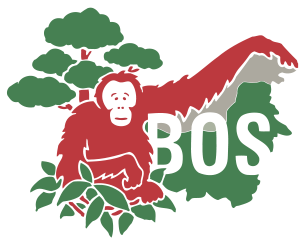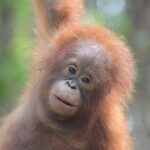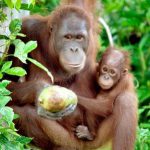The power of the hornbill
The hornbill is a perfect example of how tight nature and culture are interwoven. The unique bird with its brightly coloured and distinctively shaped bill not only helps to maintain the quality of forest ecosystems; it also plays an important role in the local Dayak traditions.
Our team members find hornbills in the Kehje Sewen Forest in East Kalimantan and on Juq Kehje Swen Island, located about ten kilometres from the edge of the forest. Juq Kehje Swen, a human-made island covering an area of about 83 hectares, is a pre-release for orangutans who have successfully completed Forest School.

Rhinoceros Hornbills are amongst the largest colourful birds found in the forests of Southeast Asia.
Hornbills, known locally as enggang or julang, belong to the Bucerotidae bird family. The scientific term ‘buceros’, referring to the shape of the bill, means ‘cow horn’ in Greek. Besides its characteristic bill, other unique hornbill traits include its large body, impressive call, and the loud flapping sound it makes when flying through the forest.
While on patrol observing orangutans, our team members have spotted several types of hornbills on the island: Rhinoceros hornbill (Buceros rhinoceros), oriental pied hornbill (Anthracoceros albirostris), black hornbill (Antracoceros malayanus), wreathed hornbill (Aceros undulatus), wrinkled hornbill (Aceros corrugatus) and bushy-crested hornbill (Anorrhinus galeritus).
For the Dayak community, the hornbill is a symbol of purity, power, and strength. This is clearly illustrated in traditional Dayak dances, in which costumes are embellished with hornbill feathers.
Dayak people also believe they can communicate with their ancestors through hornbills and that the natural spirit protecting the island of Borneo appears in the form of a legendary giant hornbill known as Panglima Burung, ‘Bird Commander’.
This beautiful big bird simply cannot be separated from the time-honoured traditions and culture of Kalimantan’s Dayak people.




